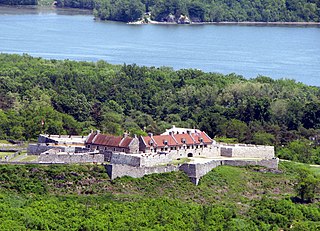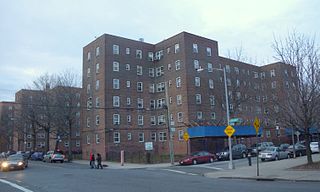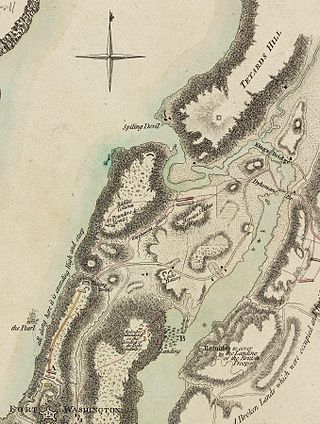
Fort Ticonderoga, formerly Fort Carillon, is a large 18th-century star fort built by the French at a narrows near the south end of Lake Champlain in northern New York. It was constructed between October 1755 and 1757 by French-Canadian military engineer Michel Chartier de Lotbinière, Marquis de Lotbinière during the action in the "North American theater" of the Seven Years' War, known as the French and Indian War in America. The fort was of strategic importance during the 18th-century colonial conflicts between Great Britain and France, and again played an important role during the American Revolutionary War.

Israel Putnam, popularly known as "Old Put", was an American military officer and landowner who fought with distinction at the Battle of Bunker Hill during the American Revolutionary War (1775–1783). He also served as an officer with Rogers' Rangers during the French and Indian War (1754–1763), when he was captured by Mohawk warriors. He was saved from the ritual burning given to enemies by the intervention of French officer Molang, with whom the Mohawks were allied. Putnam's courage and fighting spirit became known far beyond his home of Connecticut's borders through the circulation of folk legends in the American colonies and states celebrating his exploits.

The Battle of Long Island, also known as the Battle of Brooklyn and the Battle of Brooklyn Heights, was an action of the American Revolutionary War fought on August 27, 1776, at and near the western edge of Long Island in present-day Brooklyn. The British defeated the Continental Army and gained access to the strategically important Port of New York, which they held for the rest of the war. It was the first major battle to take place after the United States declared its independence on July 4, 1776, in Philadelphia. It was the largest battle of the Revolutionary War in terms of both troop deployment and combat.

The Landing at Kip's Bay was a British amphibious landing during the New York campaign in the American Revolutionary War on September 15, 1776. It occurred on the East River shore of Manhattan north of what then constituted New York City.

Red Hook is a neighborhood in western Brooklyn, New York City, United States, within the area once known as South Brooklyn. It is located on a peninsula projecting into the Upper New York Bay and is bounded by the Gowanus Expressway and the Carroll Gardens neighborhood on the northeast, Gowanus Canal on the east, and the Upper New York Bay on the west and south. A prosperous shipping and port area in the early 20th century, the area declined in the latter part of the century. Today it is home to the Red Hook Houses, the largest housing project in Brooklyn.

Fort Greene Park is a city-owned and -operated park in Fort Greene, Brooklyn. The 30.2-acre (12.2 ha) park was originally named after the fort formerly located there, Fort Putnam, itself was named for Rufus Putnam, George Washington's chief of engineers in the Revolutionary War.

The Battle of Fort Washington was fought in New York on November 16, 1776, during the American Revolutionary War between the United States and Great Britain. It was a British victory that gained the surrender of the remnant of the garrison of Fort Washington near the north end of Manhattan. It was one of the worst Patriot defeats of the war.

The Battle of Long Island, August 27, 1776, was a significant British victory in the early stages of the American Revolutionary War over American forces under the command of General George Washington, and the opening battle in a successful British campaign to gain control of New York City in 1776. The Americans had lined New York's harbor with various levels of entrenchment and fortification, which were defended by an array of Continental Army forces and militia companies from New York and nearby states. After the British made an unopposed landing on Long Island in mid-August, Washington reinforced forward positions in the hills of central Brooklyn.

Mount Independence on Lake Champlain in Orwell, Vermont, was the site of extensive fortifications built during the American Revolutionary War by the American army to stop a British invasion. Construction began in July 1776, following the American defeat in Canada, and continued through the winter and spring of 1777. After the American retreat on July 5 and 6, 1777, British and Hessian troops occupied Mount Independence until November 1777.
Philip Johnston of the New Jersey militia died in battle at the head of his regiment at the Battle of Long Island on 27 August 1776. He was a graduate of Princeton University. He was the subject of a debate in the United States Senate on 26 December 1836 concerning compensating his surviving heirs and children: Maria Scudder, Martha A. Lloyd, and Elizabeth Johnston.

Constitution Island is in the northeastern United States, located in New York on the east side of the Hudson River, north of New York City. It is directly opposite the U.S. Military Academy Reservation at West Point and is connected to the east shore by Constitution Marsh.

1776 is celebrated in the United States as the official beginning of the nation, with the Declaration of Independence of the Thirteen Colonies from the British Empire issued on July 4.

Fort Cockhill was an 18th-century military fortification located on Cox's Hill or Tubby Hook Hill, now known as the present-day Inwood Hill Park in Manhattan, New York City. A small, circular earthwork structure, in height some ten or twelve feet and equipped with two cannon, it was situated at the northwestern extremity of Tubby Hook Hill, at a point overlooking both the Hudson River and the Harlem River valley.

Fort Clinton was a stone-and-earthworks fortification on an elevation within what is now Central Park in New York City. It was built in 1814 near the present line of 107th Street, slightly west of Fifth Avenue. According to maps of the time, Fort Clinton was the easternmost of a connected series of forts, connected to Nutter's Battery on the west by earthworks and a gatehouse over the Old Post Road at the bottom of McGowan's Pass. Fort Clinton and Nutter's Battery were commanded from a third fort at the top of the pass, Fort Fish, which had a sweeping view of Long Island Sound, northern Manhattan, and Westchester County. Fort Fish was across the road from Fort Clinton and connected to Nutter's Battery by another line of earthworks.

The Maryland 400 were members of the 1st Maryland Regiment who repeatedly charged a numerically superior British force during the Battle of Long Island during the Revolutionary War, sustaining heavy casualties, but allowing General Washington to successfully evacuate the bulk of his troops to Manhattan. This action is commemorated in Maryland's nickname, the "Old Line State." A monument in Brooklyn and multiple plaques were put up in the memory of this regiment and the fallen soldiers.

HMS Phoenix was a 44-gun fifth-rate ship of the Royal Navy. She was launched in 1759 and sunk in 1780 and saw service during the American War of Independence.

HMS Roebuck was a fifth-rate ship of the Royal Navy which served in the American and French Revolutionary Wars. Designed in 1769 by Sir Thomas Slade to operate in the shallower waters of North America, she joined Lord Howe's squadron towards the end of 1775 and took part in operations against New York the following year. She engaged the American gun batteries at Red Hook during the Battle of Long Island in August 1776, and forced a passage up the Hudson River in October. On 25 August 1777, Roebuck escorted troopships to Turkey Point, Maryland, where an army was landed for an assault on Philadelphia. She was again called upon to accompany troopships in December 1779, this time for an attack on Charleston. When the ships-of-the-line, which were too large to enter the harbour, were sent back to New York, Admiral Marriot Arbuthnot made Roebuck his flagship. She was, therefore, at the front of the attack, leading the British squadron across the shoal to engage Fort Moultrie and the American ships beyond.
The Battle of Gwynn's Island saw Andrew Lewis lead patriot soldiers from Virginia against John Murray, 4th Earl of Dunmore's small naval squadron and British loyalist troops. In this American Revolutionary War action, accurate cannon fire from the nearby Virginia mainland persuaded Dunmore to abandon his base at Gwynn's Island. While camping on the island, the loyalists suffered heavy mortality from smallpox and an unknown fever, particularly among the escaped slaves that Dunmore recruited to fight against the American rebels. Gwynn's Island is located on the western shore of Chesapeake Bay in Mathews County, Virginia.

Battle Pass, formerly known as Flatbush Pass or Valley Grove or The Porte, is a historic hill pass that played a significant part in the 1776 Battle of Long Island, and that is currently part of Prospect Park in Brooklyn.
Red Hook Lane Arresick is a revolutionary war burial ground in Red Hook, Brooklyn. During the Battle of Brooklyn, General Stirling's retreating forces fought a rearguard action. Continental Army riflemen fleeing the destruction of Fort Defiance fired shots at British troops advancing on the Carnarsie Indian path through Gowanus, killing a Lt. Colonel and his aide. They and the Pennsylvanian rifleman who shot them are buried together nearby on the path later called Red Hook Lane.

















